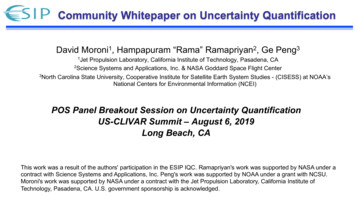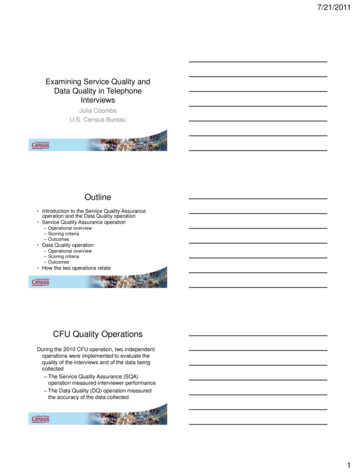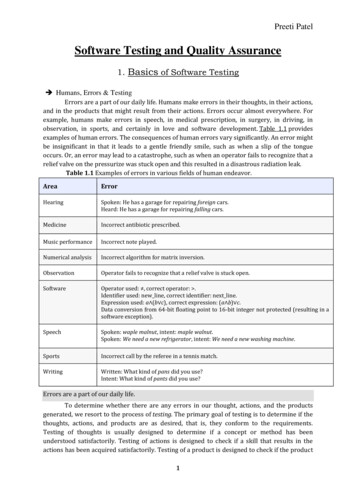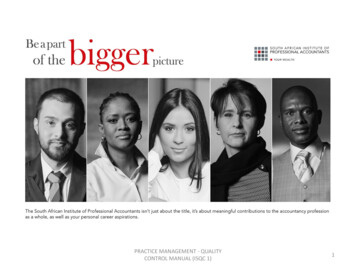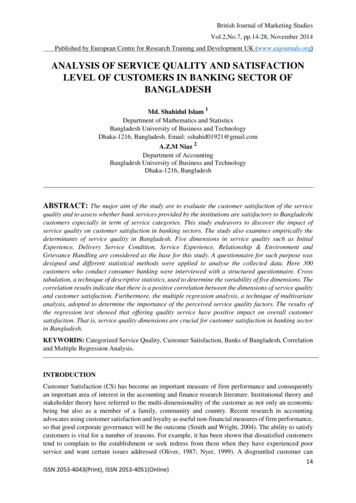
Transcription
British Journal of Marketing StudiesVol.2,No.7, pp.14-28, November 2014Published by European Centre for Research Training and Development UK (www.eajournals.org)ANALYSIS OF SERVICE QUALITY AND SATISFACTIONLEVEL OF CUSTOMERS IN BANKING SECTOR OFBANGLADESHMd. Shahidul Islam 1Department of Mathematics and StatisticsBangladesh University of Business and TechnologyDhaka-1216, Bangladesh. Email: sshahid01921@gmail.comA.Z.M Niaz 2Department of AccountingBangladesh University of Business and TechnologyDhaka-1216, BangladeshABSTRACT: The major aim of the study are to evaluate the customer satisfaction of the servicequality and to assess whether bank services provided by the institutions are satisfactory to Bangladeshicustomers especially in term of service categories. This study endeavors to discover the impact ofservice quality on customer satisfaction in banking sectors. The study also examines empirically thedeterminants of service quality in Bangladesh. Five dimensions in service quality such as InitialExperience, Delivery Service Condition, Service Experience, Relationship & Environment andGrievance Handling are considered as the base for this study. A questionnaire for such purpose wasdesigned and different statistical methods were applied to analyse the collected data. Here 300customers who conduct consumer banking were interviewed with a structured questionnaire. Crosstabulation, a technique of descriptive statistics, used to determine the variability of five dimensions. Thecorrelation results indicate that there is a positive correlation between the dimensions of service qualityand customer satisfaction. Furthermore, the multiple regression analysis, a technique of multivariateanalysis, adopted to determine the importance of the perceived service quality factors. The results ofthe regression test showed that offering quality service have positive impact on overall customersatisfaction. That is, service quality dimensions are crucial for customer satisfaction in banking sectorin Bangladesh.KEYWORDS: Categorized Service Quality, Customer Satisfaction, Banks of Bangladesh, Correlationand Multiple Regression Analysis.INTRODUCTIONCustomer Satisfaction (CS) has become an important measure of firm performance and consequentlyan important area of interest in the accounting and finance research literature. Institutional theory andstakeholder theory have referred to the multi-dimensionality of the customer as not only an economicbeing but also as a member of a family, community and country. Recent research in accountingadvocates using customer satisfaction and loyalty as useful non-financial measures of firm performance,so that good corporate governance will be the outcome (Smith and Wright, 2004). The ability to satisfycustomers is vital for a number of reasons. For example, it has been shown that dissatisfied customerstend to complain to the establishment or seek redress from them when they have experienced poorservice and want certain issues addressed (Oliver, 1987; Nyer, 1999). A disgruntled customer can14ISSN 2053-4043(Print), ISSN 2053-4051(Online)
British Journal of Marketing StudiesVol.2,No.7, pp.14-28, November 2014Published by European Centre for Research Training and Development UK (www.eajournals.org)therefore become a saboteur, dissuading other potential customers away from a particular serviceprovider. The measurement of customer satisfaction in service industries, compared to manufacturingindustries, requires special consideration due to difficulties of finding accurate measurementparameters. Of all the service industries, the banking and financial sector has a dominant position anda discussion of customer satisfaction based performance measurements in the financial sector requiresspecial attention.Customer satisfaction is a grossly neglected measure of governance in most LDCs includingBangladesh. Anecdotal evidence suggests that state-owned commercial banks (SCBs) have lost theirmarket share and are virtually on the point of closing because of their poor service quality as perceivedby their customers. In contrast, private and foreign commercial banks working in the same economicand cultural setting are growing rapidly with higher profits and market share. Banking is one of themost sensitive businesses all over the world. A bank is a financial intermediary that accepts depositsand channels those deposits into lending activities, either directly or through capital markets. It is ahighly regulated industry with detailed and focused regulators. Bank, a service selling institution, playsa significant role in a contemporary world of money and economy. It influences and facilitates manydifferent but integrated economic activities such as resource mobilization, poverty elimination,production, and distribution of public finance. Bangladesh has a well-developed banking system, whichconsists of a wide variety of institutions ranging from a central bank to commercial banks and tospecialized agencies to cater special requirements of specific sectors. The country started without anyworthwhile banking network in 1947 but witnessed phenomenal growth in the first two decades. Hence,it is essential to identify the factors responsible for the quality of the services.Bank is a customer oriented services industry. A bank depends upon the customers for their survival inthe market. The customer is the focus and customer service is the differentiating factors (Guo et al.,2008). A bank can differentiate itself from competitors by providing high quality customer service(Naeem & Saif, 2009. Research indicates that companies with an excellent customer service recordreported a 72% increase in profit per employee, compared to similar organizations that havedemonstrated poor customer service; it is also five times costlier to attract new customers than to retainexisting customers (Duncan, 2004). In Bangladesh, customers in the banking sector are in a strongbargaining position due to the significant growth of banks. Therefore, banks have to provide servicecarefully because of the availability of banks. Service quality has been a vital issue of discussion andresearch over the past three decades. Research on service quality has well established that the customerperception of the quality of a service depends on customer’s pre-service expectations. Studies byParasuraman et al. (1985), Zeithmal et al. (1990), noted that the key strategy for the success and survivalof any business institution is the deliverance of quality services to customers. Equally well, dissatisfiedcustomers are more likely to tell another ten people about their unfortunate experiences with a particularorganization. In order to achieve customer satisfaction, organizations must be able to build and maintainlong lasting relationships with customers through satisfying various customers’ needs and demands(Pizam & Ellis, 1999). Otherwise, the combined effect of negative word-of-mouth, switching andreduced consumption will affect the productivity and profitability of the bank.RESEARCH OBJECTIVESCustomer satisfaction is essential for the success of service firms like banks. The quality of service hasbecome an aspect of customer satisfaction. Day by day it has been proven that service quality is relatedto customer satisfaction. So the main research objectives of this study are:15ISSN 2053-4043(Print), ISSN 2053-4051(Online)
British Journal of Marketing StudiesVol.2,No.7, pp.14-28, November 2014Published by European Centre for Research Training and Development UK (www.eajournals.org)1. To judge the importance of attributes that influence customer’s satisfaction with banks ofBangladesh in terms of service dimensions: Initial Experience, Delivery Service Condition, ServiceExperience, Relationship & Environment and Grievance Handling.2. To rank the determinants of service quality and understanding satisfactionlevel of the customers.3. To investigate the relationship between basic serviceand customer satisfaction.RESEARCH HYPOTHESESThis research is conducted to address the following null hypotheses and alternative hypotheses:H0:- There is no strong relationship between service quality dimensions and customer satisfaction inbanking services.H1:- There is a strong relationship between service quality dimensions and customer satisfaction inbanking services.H0:- Service quality has no significant impact on overall customer satisfaction.H2:- Service quality has significant impact on overall customer satisfactionLITERATURE REVIEWSiddiqi (2011) conducted a survey of 100 retail banking customers in Bangladesh to establish therelationships between service quality attributes, customer satisfaction and customer loyalty. His studyalso supported the contention that all service quality attributes are positively related to customersatisfaction, and customer satisfaction is positively related to customer loyalty in the retail bankingsettings in Bangladesh. Jahiruddin and Haque (2009) surveyed 198 bank customers in Khulna, the thirdlargest city in Bangladesh to explore the pattern of preferences and relative importance of differentfactors to customers when selecting their preferred banks. Service quality is considered an importanttool for a firm’s struggle to differentiate itself from its competitors (Ladhari, 2008). Service quality hasreceived a great deal of attention from both academicians and practitioners (Negi, 2009) and servicemarketing literature defined service quality as the overall assessment of a service by the customer(Eshghi et al., 2007).In the changing banking scenario of 21st century, the banks had to have a vital identity to provideexcellent services. Banks nowadays have to be of world-class standard, committed to excellence incustomer’s satisfaction and to play a major role in the growing and diversifying financial sector (Guoet al., 2008). There has been a remarkable change in the way of banking in the last few years. Customershave also accurately demanded globally quality services from banks. With various choices available,customers are not willing to put up with anything less than the best. Banks have recognized the need tomeet customer’s aspirations. Consequently service quality is a critical motivating force to drive the bankup in the high technology ladder. Banking industry is a demand driven industry, which constitute animportant part of the service industry (Newman & Cowling, 1996). Banks have to redefine theircorporate image to that emphasizes service quality since it provides many advantages to a companysuch as allowing the company to differentiate itself from its competitors by increasing sales and marketshares, providing opportunities for cross selling, improving customer relations thus enhancing thecorporate image, reliability, responsiveness, credibility and communication results in the satisfactionand retention of customers and employee, thus reducing turnover rate (Newman, 2001).In line with Tsoukatos and Rand (2006), customer satisfaction is a key to long-term business success.To protect or gain market shares, organizations need to outperform competitors by offering high qualityproduct or service to ensure satisfaction of customers. In proportion to Magesh (2010), satisfactionmeans a feeling of pleasure because one has something or has achieved something. It is an action offulfilling a need, desire, demand or expectation. Customers compare their expectations about a specific16ISSN 2053-4043(Print), ISSN 2053-4051(Online)
British Journal of Marketing StudiesVol.2,No.7, pp.14-28, November 2014Published by European Centre for Research Training and Development UK (www.eajournals.org)product or services and its actual benefits. As stated by Kotler & Armstrong, (2010), satisfaction as aperson’s feelings of pleasure or disappointment resulting from the comparison of product’s perceivedperformance in reference to expectations. Relationship between Service Quality and CustomerSatisfaction is very important for a bank. Quality and customer satisfaction have long been recognizedas playing a crucial role for success and survival in today's competitive market. Regarding therelationship between customer satisfaction and service quality, Oliver (1993) first suggested that servicequality would be antecedent to customer satisfaction regardless of whether these constructs werecumulative or transaction-specific. Although it is stated that other factors such as price and productquality can affect customer satisfaction, perceived service quality is a component of customersatisfaction (Zeithaml & Bitner, 2003). The relationship between service quality and customersatisfaction is becoming crucial with the increased level of awareness among bank customersDemographic characteristics should be considered by the bank managers to understand their customers.As said by Wilson et al. (2008), service quality is a focused evaluation that reflects the customer’sperception of reliability, assurance, responsiveness, empathy and tangibility while satisfaction is moreinclusive and it is influenced by perceptions of service quality, product price and quality, also situationalfactors and personal factors.RESEARCH FRAMEWORKSince the main objective of the study is to identify the impact of the five dimensions of service qualityon customer satisfaction thus the framework of this study is given lationship&EnvironmentGrievanceHandlingFigure 1: Research FrameworkRESEARCH METHODOLOGYTo understand the savings preference, bank preference, services taken, time period since becomingcustomer and to identify the information sources influencing bank selection, a questionnaire wasdesigned and the respondents were asked to mark their preferences on a ranking scale. The questionnairealso contains 19 factors that affect the customer satisfaction. These factors are divided into 5 major17ISSN 2053-4043(Print), ISSN 2053-4051(Online)
British Journal of Marketing StudiesVol.2,No.7, pp.14-28, November 2014Published by European Centre for Research Training and Development UK (www.eajournals.org)groups - Initial Experience, Delivery Service Condition, Service Experience, Relationship &Environment and Grievance Handling. These factors are:Initial Experience :Level of product knowledge of bank staff ; Quality of response to customer querieson service ; Understanding of customer’s needs & unique perspective ; Availability and quality ofbrochures, Sales materials ; Presentation, Communication and Mannerism of staff.Delivery Service Condition: Timeliness of service delivery; Sharing of status while work-in progress;Quality and Sophistication of delivery; Behaviour and mannerism of delivery staff; Level of congruencebetween time taken to deliver the services and stipulated time.Service Experience: Level of service quality vis-à-vis expectation; Level of need fulfilment vis-à-visexpected.Relationship & Environment: Frequency and quality of contact; Knowledge of company productsand customer opportunities; Conduct and communication of relationship person.Grievance Handling: Timeliness of complaint resolution; Quality of complaint resolution; Level ofiterations till the complaint was resolved; Knowledge and empathy of the customer servicing staffAs the study is about measuring service quality and customer satisfaction of the banks, the populationincluded mainly clients of different Public and private banks like- Sonali Bank, Janata Bank, Brac Bank,Islami Bank, Al Arafa Islami Bank, Bank Asia, City Bank, Dutch Bangla Bank, Eastern Bank Ltd.,National Bank, Agrani Bank, Dhaka Bank and The Standard Chartered Bank, which are located in theDhaka City of Bangladesh. In this study 300 respondents of different banks have been selected by usingconvenience sampling method.A survey was conducted in various public and private banks in Bangladesh to collect primary data byusing structured questionnaire. A convenience sampling process has been used to collect data for thisresearch. All questions are closed-ended because all possible answers were given to the respondents.Respondents were asked to respond about their perceptions of the quality of services provided by banksin Bangladesh in terms of the above mentioned five services quality dimensions. To record theresponses of the sample respondents, a structured questionnaire was used. The five-point Likert scale(where 1 Highly Satisfied to 5 Not at all Satisfied) has been used for the main research questions.After data collection, by using SPSS software (17.0 versions), Descriptive Statistics, correlation andmultiple regressions analysis have been conducted to test the strength of associations between the studyvariables.Table 1: Frequency and Percentage distribution of the Personal background of the respondentsare as follows:Characteristics of the respondentsFrequencyPercentage (%)GenderMaleFemale1921083006436100Below 007822100TotalAge25-3535-4545-5555 and AboveTotalMarital statusUnmarriedTotal18ISSN 2053-4043(Print), ISSN 2053-4051(Online)
British Journal of Marketing StudiesVol.2,No.7, pp.14-28, November 2014Published by European Centre for Research Training and Development UK r secondaryUndergraduateGraduateTotalOccupationGovt. servicePrivate serviceBusinessHousewivesOthersTotalMonthly IncomeBelow 0 and AboveTotalNature of accountFixed depositSavings AccountCurrent AccountOthersTotalTime duration of relationship with banksLess than 3 year3-7 years7-11 years11 and Above 431430033.747.314.34.7100FINDINGS AND ANALYSISFactors analysis that affect the customer satisfactionfrequency and percentage distribution of 19 factors that affect the customer satisfaction. These factorsare divided into 5 major groups - Initial Experience, Delivery Service Condition, Service Experience,Relationship & Environment and Grievance Handling. Also ranking all factors which are based onpercentage of Highly Satisfied. Here we consider, 1 Highly Satisfied, 2 Satisfied, 3 ModeratelySatisfied, 4 Dissatisfied, 5 Not at all Satisfied.19ISSN 2053-4043(Print), ISSN 2053-4051(Online)
British Journal of Marketing StudiesVol.2,No.7, pp.14-28, November 2014Published by European Centre for Research Training and Development UK (www.eajournals.org)Initial ExperienceAttributesLevel of product knowledge ofbank staffQuality of response tocustomer queriesUnderstanding of customer’sneeds & unique perspectiveAvailability and quality ofbrochures, Sales materialsPresentation, Communicationand Mannerism of staff1No. of (5.7%)65(21.7%)25(8.3%)12345Ranking(Based on percentage ofHighly Satisfied)Quality of response tocustomer queriesUnderstanding of customer’sneeds & unique perspectiveLevel of product knowledgeof bank staffPresentation, Communicationand Mannerism of staffAvailability and quality ofbrochures, Sales materialsService Delivery ExperienceAttributesNo. of Respondents2345Timeliness of service delivery 165(55%)Sharing of status while work- 151in-progress(50.3%)Quality and Sophistication70(23.3%)Behaviour and mannerism of 144delivery 3.7%)0(0%)3(1%)19(6.4%)8(2.6%)Level of congruence between 116time taken to deliver the (38.7%)services and stipulated time89(29.7%)58(19.3%)21(7%)16(5.3%)1Ranking(Based on percentage of HighlySatisfied)1 Timeliness of service delivery2 Sharing of status while workin-progress3 Behaviour and mannerism ofdelivery staffLevel of congruence between4 time taken to deliver theservices and stipulated time5 Quality and SophisticationService ExperienceAttributesNo. of Respondents1Ranking2345Level of service quality 6720558672vis-à-vis expectation(6.7%)(18.3%)(28.7%)(24%)Level of need fulfilment 169903173vis-à-vis expected(30%)(10.3%)(2.4%)(1%)(22.3%)(56.3%)(Based on percentage of HighlySatisfied)1 Level of need fulfilment vis-à-visexpected2Level of service quality vis-à-visexpectation20ISSN 2053-4043(Print), ISSN 2053-4051(Online)
British Journal of Marketing StudiesVol.2,No.7, pp.14-28, November 2014Published by European Centre for Research Training and Development UK (www.eajournals.org)Relationship ExperienceAttributes1No. of (3.3%)Knowledge of company products 106and customer Conduct and communication of 60relationship uency and quality of contactRanking(Based on percentage ofHighly Satisfied)1 Frequency and quality ofcontactKnowledge of companyproducts and tionship personGrievance HandlingAttributes1Timelinessofcomplaint 75No. of Respondents2345Ranking(Based on percentageHighly (5%)Quality of complaint 3%)Level of iterations till the 11090552817complaint was (23.3%)55(18.4%)(36.7%)Knowledge and empathy of the 60customer servicing staff(20%)Qualityofcomplaintresolution2Level of iterations till thecomplaint was resolved3Timeliness of complaintresolution4Knowledge and empathyof the customer servicingstaffDescriptive StatisticsHere we represents Mean, standard deviation, Average mean and Average Std. deviation of all factorswhich are divided into 5 groups.Table 2: Descriptive .19.8493004.14.865InitialExperienceLevel of product knowledge of bankstaffQuality of response to customerqueriesUnderstanding of customer’s needs &unique perspectiveAvailability and quality of brochures,Sales td.deviation4.22.80121ISSN 2053-4043(Print), ISSN 2053-4051(Online)of
British Journal of Marketing StudiesVol.2,No.7, pp.14-28, November 2014Published by European Centre for Research Training and Development UK ngPresentation, Communication andMannerism of staffTimeliness of service deliverySharing of status while work-inprogressQuality and SophisticationBehaviour and mannerism of deliverystaffLevel of congruence between timetaken to deliver the services andstipulated timeLevel of service quality vis-à-visexpectationLevel of need fulfilment vis-à-visexpectedFrequency and quality of contactKnowledge of company products andcustomer opportunitiesConduct and communication ofrelationshippersonTimeliness of complaint resolutionQuality of complaint resolutionLevel of iterations till the complaintwas resolvedKnowledge and empathy of thecustomer servicing 4.8664.20.8114.03.8714.07.8654.11.841Table-2 has shown the statistical description of service quality with customer satisfaction. From tableit has found that banks customers perceived Initial Experience (with the highest mean scores, i.e. Mean 4.22, Standard deviation 0.801) to be the most dominant service quality and evident to aconsiderable extent, followed by Service Experience (Mean 4.20, Standard deviation 0.811),Grievance Handling (Mean 4.07, Standard deviation 0.865) and Delivery Service Condition (Mean 4.04, Standard deviation 0.866) which are rated as moderate practices of their bank. Relationship& Environment (Mean 4.03, Standard deviation 0.871) with the lowest mean score is perceived onthe overall as least dimension of service quality in public and private banks of Bangladesh. The averagemean value of customer satisfaction is 4.11 and standard deviation is 0.841.The standard deviations arequite high, indicating the dispersion in a widely-spread distribution. This means that the effects ofservice quality on customer satisfaction are an approximation to a normal distribution. This alsoindicates that respondents are in favour of customer satisfaction.Correlation AnalysisCorrelation coefficients are used in statistics to measure how strong a relationship is between twovariables. The quantity r, called the linear correlation coefficient, measures the strength and the directionof a linear relationship between two variables. The linear correlation coefficient is sometimes referredto as the Pearson product moment correlation coefficient in honor of its developer Karl Pearson. Themathematical formula for computing r is:22ISSN 2053-4043(Print), ISSN 2053-4051(Online)
British Journal of Marketing StudiesVol.2,No.7, pp.14-28, November 2014Published by European Centre for Research Training and Development UK (www.eajournals.org)Where, n is the number of pairs of data.Table 3: Correlation analysis ationSig. (2-tailed)NPearsonCorrelationSig. (2-tailed)NPearsonCorrelationSig. .0021N300300300Pearson.723.721.8001CorrelationSig. (2-tailed) 699.753HandlingCorrelationSig. (2-tailed) 1.824.822CustomerCorrelationSatisfactionSig. (2-tailed) .000.000.000.000N300300300300Note: Correlation is significant at the 0.05 level of significance 0Bivariate Correlations is used to know the nature, direction and significance of the bivariate relationshipof the variables of this study. Based on the analysis presented in Table 3, the results show that there isa positive correlation between the variables, the correlation between Initial Experience and DeliveryService Condition, indicates that there is a significant correlation between two variables with coefficientcorrelation r .813 at p 0.00 level. The correlation between Initial Experience and Service Experience,indicates that there is a significant correlation between two variables with coefficient correlation r .751 at p 0.00 level. Similarly the correlation between Initial Experience and Relationship &Environment, Initial Experience and Grievance Handling, Initial Experience and Overall CustomerSatisfaction, indicates that there are a significant correlation between two variables with coefficientcorrelation r .723 at p 0.00 level, r .642 at p 0.01 level, r .841 at p 0.00 level.The correlation between Delivery Service Conditionand Service Experience, indicates that there is asignificant correlation with coefficient correlation r .607 at p 0.02 level. Similarly the correlationbetween Delivery Service Condition and Relationship & Environment , Delivery Service Condition andGrievance Handling, Delivery Service Condition and Overall Customer Satisfaction, indicates that there23ISSN 2053-4043(Print), ISSN 2053-4051(Online)
British Journal of Marketing StudiesVol.2,No.7, pp.14-28, November 2014Published by European Centre for Research Training and Development UK (www.eajournals.org)are a significant correlation with coefficient correlation r .721 at p 0.01 level,r .811 at p 0.00level, r .781 at p 0.00 level.The correlation between Service Experience and Relationship & Environment, indicates that there is asignificant correlation between two variables with correlation coefficient, r .586 at p 0.00 level.Similarly the correlation between Service Experience and Grievance Handling, Service Experience andOverall Customer Satisfaction, indicates that there are a significant correlation with correlationcoefficient r .800 at p 0.00 level,r .699 at p 0.02 level, r .824 at p 0.00 level.The correlation between Relationship & Environment and Grievance Handling, Relationship &Environment and Customer Satisfaction, indicates that there are a significant correlation withcoefficient correlation r .753 at p 0.00 level and r .822 at p 0.00 level.Finally, the correlationbetween Grievance Handling and Customer satisfaction, indicates that there is a significant correlationbetween two variables with coefficient correlation r .812 at p 0.00 level.So we conclude that there is a strong relationship between service quality dimensions and customersatisfaction in banking services.Multiple Regression AnalysisIn this part of the analysis includes a regression model to test the hypotheses. Five extracted dimensionswere taken as independent variables against overall satisfaction of the customers as dependent variablein a multiple regression model. For all the hypotheses of the study below hypothesis test was used at95% confidence interval.To know about the impact of the individual dimensions of bank service quality on overall customersatisfaction, multiple regressions using the following model is run:Y α 𝞫1X1 𝞫2X2 𝞫3X3 𝞫4X4 𝞫5X5 e .(1)Where, Y Overall Customer Satisfaction, X1 Initial Experience, X2 Delivery Service Condition,X3 Service Experience, X4 Relationship & Environment, X5 Grievance Handling.Table- 4: Model SummaryModel(1)R.904RSquare.817Adjusted Std.R Square Error e.817FChangedf1df2Sig. FChange44.6715294.000Predictors: (Constant), Initial Experience, Delivery Service Condition, Service
the regression test showed that offering quality service have positive impact on overall customer satisfaction. That is, service quality dimensions are crucial for customer satisfaction in banking sector in Bangladesh. KEYWORDS: Categorized Service Quality, Customer Satisfaction, Banks of Bangladesh, Correlation and Multiple Regression Analysis.



